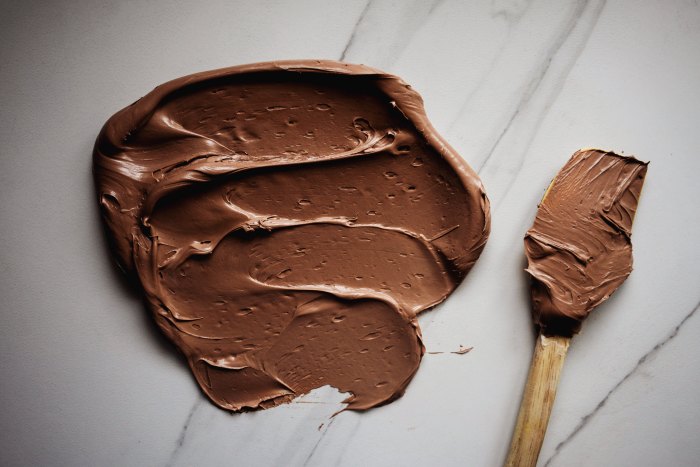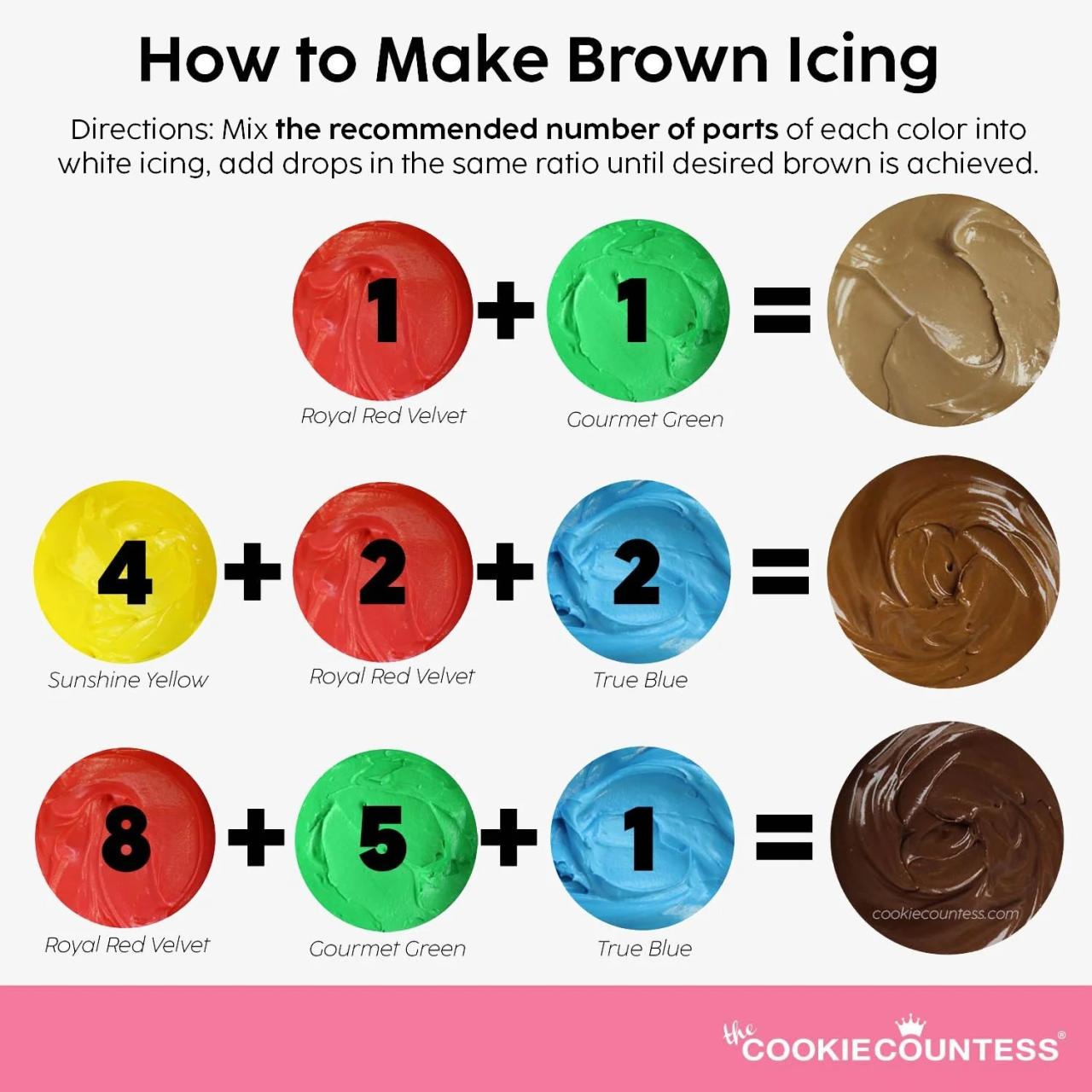Understanding Brown Food Coloring: What Two Colors Make Brown Food Coloring

What two colors make brown food coloring – The seemingly simple brown food coloring actually holds a surprising depth of complexity. Achieving the perfect shade of brown, from the rich, dark depths of espresso to the warm, light hue of milk chocolate, requires a nuanced understanding of color mixing and the underlying chemical components. This exploration delves into the fascinating world of brown food coloring, uncovering the secrets behind its diverse palette and revealing the natural alternatives that mimic its captivating hues.Brown food coloring isn’t a single entity; it’s a spectrum.
The depth and warmth of the brown depend entirely on the precise combination of other colors used to create it. Understanding this allows for precise control over the final result, transforming a simple ingredient into a powerful tool for culinary artistry.
Shades of Brown Achievable with Food Coloring
The range of browns achievable with food coloring is remarkably broad. From a pale, sandy beige reminiscent of light-roasted coffee beans to a deep, almost black chocolate brown, the possibilities are limited only by the imagination and skill of the user. Subtle variations in the ratios of the base colors can produce a stunning array of shades, ranging from warm, reddish-browns to cool, grayish-browns.
Consider the difference between the earthy brown of a mushroom and the rich, almost burgundy brown of a dark chocolate truffle – both are achievable through careful manipulation of color combinations. Even subtle shifts in lighting can drastically alter the perceived shade, adding another layer of complexity to this versatile coloring.
Chemical Composition of Brown Food Colorings
Typical brown food colorings are often a blend of several different dyes, rather than a single pigment. Common components include caramel coloring, which is derived from the heating of sugars, and various synthetic dyes like Yellow 5, Yellow 6, Red 40, and Blue 1. The precise proportions of these dyes determine the final shade of brown. For instance, a higher concentration of Red 40 will result in a warmer, more reddish-brown, while a greater proportion of Blue 1 will create a cooler, more grayish-brown.
The specific chemical structure of each dye influences its light-absorbing properties, which in turn determines the hue and intensity of the resulting brown.
Variations in Intensity and Hue Based on Base Colors
The intensity and hue of the resulting brown are directly influenced by the base colors used and their ratios. A brown created primarily from red and yellow will exhibit warmer tones, often leaning towards reddish-brown or amber. Incorporating blue into the mix shifts the hue towards cooler shades, creating browns with grayish or even purplish undertones. Increasing the overall concentration of the base colors intensifies the brown, making it darker and more saturated.
Conversely, diluting the mixture with water or other liquids results in a lighter, less intense brown. The precise interplay of these factors allows for exceptional control over the final color.
Examples of Natural Ingredients Creating Brown Hues
Nature offers a plethora of ingredients that produce beautiful brown hues. Cocoa powder, for example, provides a rich, dark brown with chocolatey undertones. Caramel, derived from the heating of sugars, offers a range of browns from light golden to deep, almost black. Coffee grounds can create a subtle, earthy brown, while molasses adds a deeper, richer brown with hints of sweetness.
These natural options not only provide color but also add unique flavor profiles, making them attractive alternatives to synthetic food colorings in many applications.
So, you’re wondering what makes brown food coloring? Well, it’s not as simple as mixing just two colors, it’s more like a culinary conspiracy! But if you’re into weird science experiments, check out this awesome reaction between food coloring, milk, and dish soap – food coloring milk and dish soap – it’s way more exciting than figuring out the brown color mystery! Anyway, back to brown…probably a mix of red and green, or maybe yellow and purple; it’s a color-mixing enigma, really.
Impact of Additives and Other Ingredients

The quest for the perfect shade of brown in food coloring is a fascinating journey, one where the seemingly simple act of mixing colors transforms into a delicate dance of chemistry and artistry. The final hue isn’t solely determined by the initial blend of primary colors; a whole world of influencing factors exists, subtly shifting the outcome and adding layers of complexity to the process.
Understanding these factors allows for greater control and precision in achieving the desired brown.The addition of other ingredients dramatically alters the final brown color. Think of it like painting: you start with your base colors, but then you introduce other pigments to modify the overall effect. This is true for food coloring as well. The interaction between these additional components and the base food coloring creates a surprising range of possibilities.
Influence of Cocoa Powder and Caramel
Cocoa powder, with its rich, earthy tones, instantly deepens and warms a brown base. A small amount can shift a light brown to a more intense, chocolatey shade, while a larger quantity will create a much darker, almost black-brown. Similarly, caramel, with its warm, amber hues, can add a subtle sweetness to the brown, creating a lighter, more golden-brown.
The concentration of either ingredient directly correlates to the intensity of the color shift. A small amount of cocoa powder might add depth, whereas a larger amount will significantly darken the mixture. Conversely, a small amount of caramel might add a slight golden undertone, whereas a larger amount could result in a noticeably lighter, more amber-toned brown.
pH Level’s Effect on Brown Shade
The pH level of the mixture plays a surprisingly significant role in the final brown shade. Acidity or alkalinity can subtly shift the color, sometimes leading to unexpected results. A more acidic environment might cause a slight reddening of the brown, whereas a more alkaline environment could lean towards a more greenish-brown. This is because the pH affects the chemical structure of the color molecules, causing them to reflect light differently.
Imagine a delicate balance – a slight shift in pH can tilt the brown towards warmer or cooler tones. For instance, adding a touch of lemon juice (acidic) to a brown mixture might subtly shift it towards a reddish-brown, while adding a pinch of baking soda (alkaline) could nudge it towards a slightly more olive-toned brown.
Impact of Water-Based and Oil-Based Food Colorings
The type of food coloring used also influences the final color. Water-based food colorings tend to blend more easily with water-based ingredients, creating a smooth, even color. Oil-based food colorings, on the other hand, are better suited for oil-based mixtures, and their interaction with water can be unpredictable, potentially leading to separation or uneven coloring. It’s crucial to choose the right type of food coloring for the recipe to achieve a consistent and desirable brown.
Using a water-based coloring in an oil-based recipe, or vice versa, could lead to a mottled, uneven color or even a complete failure to incorporate the coloring.
Creating a Specific Shade of Brown: A Step-by-Step Guide
Creating a specific shade of brown requires careful attention to detail and a delicate hand. The following procedure Artikels the creation of a rich, deep chocolate brown using a combination of primary colors and cocoa powder.
- Gather your ingredients: Red, yellow, and blue food coloring (water-based), unsweetened cocoa powder, and a mixing bowl.
- Begin with the base: Start by mixing equal parts red and yellow food coloring. This creates an orange base.
- Add blue for depth: Gradually add blue food coloring, a drop at a time, until you achieve a dark, muddy brown. Observe carefully as the color shifts; the goal is a deep, rich brown, not a gray or purple tone.
- Incorporate cocoa powder: Add a small amount of cocoa powder, stirring continuously to prevent clumping. Begin with a teaspoon and add more gradually until the desired intensity is achieved. The cocoa powder will add depth and richness to the brown, making it appear more chocolatey and less muddy.
- Adjust as needed: Continue adjusting the amounts of blue and cocoa powder until the exact shade of chocolate brown is obtained. Small adjustments can make a big difference in the final result.
Variations in Brown Food Coloring

The world of brown food coloring is far richer and more nuanced than one might initially assume. A simple “brown” encompasses a vast spectrum of shades, from the deep, dark richness of espresso to the warm, inviting hue of milk chocolate, each capable of evoking entirely different emotions and culinary experiences. This incredible variety stems from a fascinating interplay of factors, leading to a delightful complexity in the final product.The wide range of brown shades available is a result of the intricate combinations of different colorants used in their creation.
Manufacturers carefully manipulate the ratios of yellow, red, and blue dyes, often incorporating other pigments like black or even brown itself to achieve specific hues. The base ingredients, the manufacturing process, and even the interaction with other food components all play significant roles in the final color’s appearance. Consider, for example, the difference between a caramel-based brown and one created solely with artificial dyes – the depth and complexity of the color differ dramatically, impacting the overall aesthetic of the final product.
Commercial Brown Food Coloring Variations
Commercially available brown food colorings come in a variety of forms, each with its own unique characteristics. Some are liquid concentrates, offering ease of use and precise control over color intensity. Others are in powdered form, providing a longer shelf life and potentially better stability in certain applications. Gel-based food colorings provide exceptional intensity and vibrancy, ideal for applications where a deep, rich brown is desired.
The specific brand and formulation significantly influence the final color, with some leaning towards warmer, reddish-browns, while others yield cooler, more grayish-browns. For instance, one brand might emphasize a deep, chocolatey brown, while another aims for a lighter, more caramel-like shade. This variance allows for a tailored approach to coloring, enabling bakers and food manufacturers to precisely match their desired aesthetic.
Intensity and Opacity Differences, What two colors make brown food coloring
The intensity and opacity of brown food colorings vary greatly depending on their formulation and concentration. Highly concentrated liquid colorings, for instance, will produce a much deeper, more saturated brown than a diluted version. Similarly, gel food colorings often exhibit higher opacity, meaning they mask the underlying color of the food more effectively. This is particularly relevant in applications like cake frosting, where a vibrant, consistent brown is crucial.
Conversely, less concentrated or transparent brown food colorings might be preferred for applications where a subtle color enhancement is desired, allowing the natural hues of the ingredients to still shine through. The difference in opacity can dramatically change the final look; a highly opaque brown might appear almost black in a thin layer, while a less opaque version will show a more translucent, lighter brown.
This subtlety in color intensity and opacity is a crucial element for professional bakers and food stylists, allowing them to achieve a precise and desired aesthetic.
Helpful Answers
Can I use only one color to make brown food coloring?
No, a single color cannot create brown. Brown is a composite color requiring a combination of at least two colors.
What is the difference between water-based and oil-based brown food coloring?
Water-based food coloring is generally more vibrant and mixes easily with water-based ingredients. Oil-based coloring is better suited for oil-based products and often provides a richer, more intense color.
How can I adjust the intensity of my brown food coloring?
Add white to lighten the shade or black to deepen it. Adjusting the ratio of the base colors will also alter the intensity and hue.
